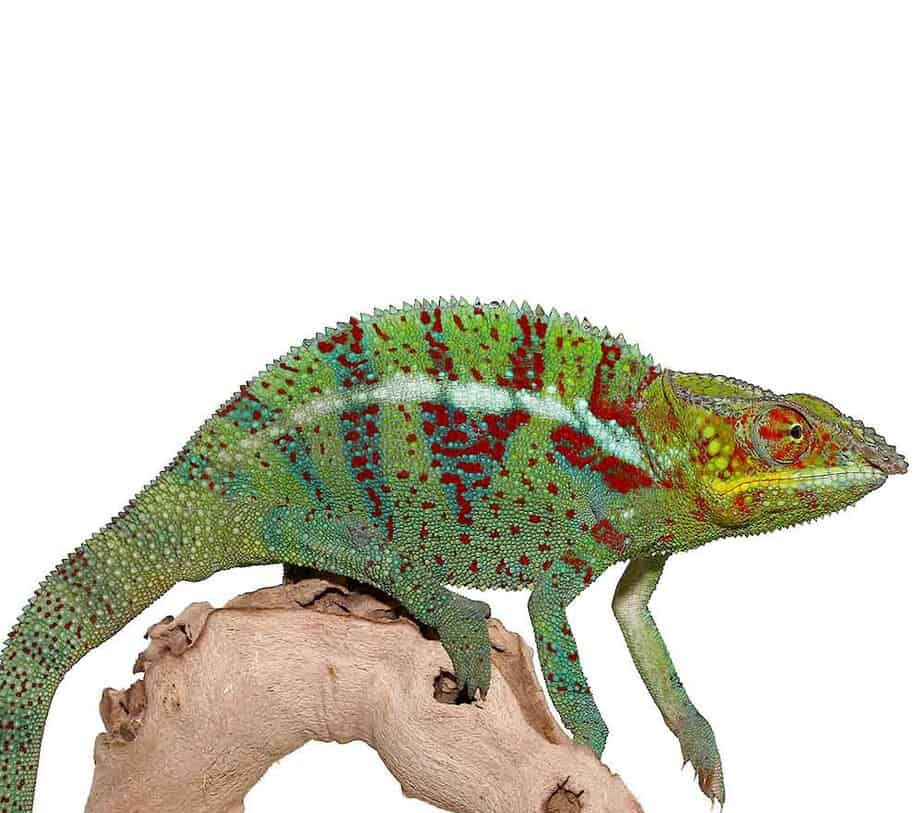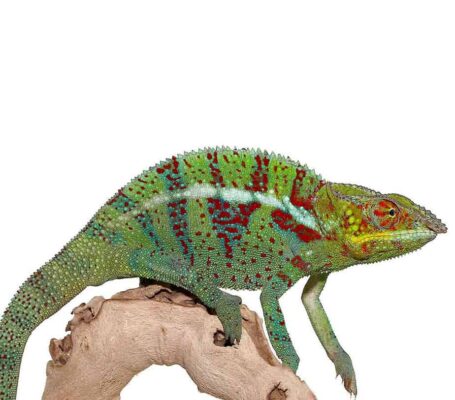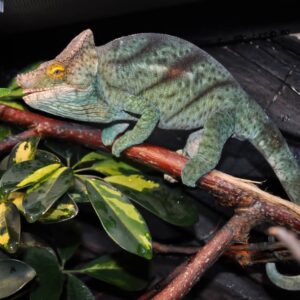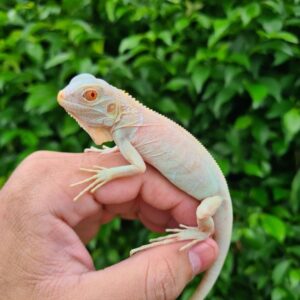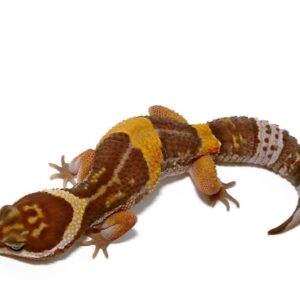Ambanja Panther Chameleon For Sale
$449.99
WE HAVE AMBANJA PANTHER CHAMELEONS FOR SALE. HERE ARE SOME HIGHLIGHTS:
- Furcifer pardalis
- Captive Bred
- Males and Females
- Approximate Sizes Ranging From 12 – 18 In Length
- Adults Are Averaging Around 12 – 18 Inches In Total Length
- Feeding On Vitamin Dusted Crickets, Worms And Roaches
FUN FACTS!
- This Is One Of The Most Popular Species Of Chameleons Due To Their Extreme Coloration
- Males Chameleons Display The Brighter Colors With Females Typically Being More Plain
- Originating From Madagascar These Range From The Coastal Central To North Eastern Madagascar
- With Proper Care They Can Live Up To 3 – 5 Years
- Arboreal Species, Provide Plenty Of Fake Plants And Branches
- A Misting Or Dripping System For Water Is Best, Manual Misting Also Works
Description
The Ambanja Panther Chameleon, scientifically known as Furcifer pardalis, is a captivating reptile species native to the lush and diverse ecosystems of Madagascar. Recognized for its striking coloration and unique adaptive features, this chameleon is a true marvel of nature. The Ambanja variety, in particular, hails from the region around the town of Ambanja in northwestern Madagascar, an area characterized by its tropical climate and abundant flora.
Belonging to the family Chamaeleonidae, the Ambanja Panther Chameleon is distinguished by its vibrant color palette, which ranges from brilliant blues and greens to vivid reds and purples. These colors are not merely for show; they play a crucial role in communication and camouflage within their natural habitat. The males are especially noted for their intense hues, which they use to attract mates and assert dominance, while females are generally more subdued in coloration.
The allure of the Ambanja Panther Chameleon extends beyond its visual appeal. It is a popular choice among reptile enthusiasts and herpetologists due to its relatively docile nature and the ease with which it can adapt to captivity when provided with proper care. Enthusiasts are often drawn to the species for its intriguing behaviors and the challenge of replicating its natural environment.
Unique features that set the Ambanja Panther Chameleon apart from other subspecies include its large size, with males reaching up to 20 inches in length, and its exceptional ability to change color. This color change is facilitated by specialized cells called chromatophores, allowing the chameleon to blend seamlessly into its surroundings or display a dazzling array of colors.
Overall, the Ambanja Panther Chameleon stands out as a remarkable example of evolutionary adaptation and natural beauty, making it a fascinating subject for both scientific study and pet ownership. Its combination of vivid coloration, distinctive physical traits, and engaging behavior continues to captivate and inspire all who encounter this extraordinary reptile.
Physical Characteristics and Color Morphs
The Ambanja Panther Chameleon, a subspecies native to the Ambanja region of Madagascar, is renowned for its striking physical characteristics and vibrant color morphs. These chameleons typically grow to an average length of 15-20 inches, with males generally being larger than females. The body structure of the Ambanja Panther Chameleon is robust, featuring a prehensile tail and zygodactylous feet, which aid in their arboreal lifestyle.
A defining trait of the Ambanja Panther Chameleon is its extraordinary coloration. The males are particularly noted for their vivid hues, which range from bright blues and greens to reds and purples. Females, on the other hand, display more subdued colors, often in shades of brown, peach, and pink. This sexual dimorphism is a key characteristic, making it relatively easy to distinguish between the two sexes.
Color morphs in Ambanja Panther Chameleons are influenced by a variety of factors, including mood, health, and environmental conditions. For instance, a healthy male might exhibit intense blue and green colors when calm, which can shift to darker shades or even red when stressed or excited. These color changes are facilitated by specialized cells called chromatophores, which expand or contract to alter the chameleon’s appearance.
Additionally, the Ambanja Panther Chameleon exhibits several distinct color morphs within the subspecies. These morphs are often named after the regions they are found in, such as the “Blue Ambanja,” which is characterized by its dominant blue hue, and the “Purple Ambanja,” known for its striking purple and red patterns. These variations not only add to the chameleon’s allure but also play a role in their mating rituals, where males display their brightest colors to attract females.
Understanding the physical characteristics and color morphs of the Ambanja Panther Chameleon provides valuable insight into their behavior and ecology, highlighting the intricate relationship between their appearance and their environment.
Natural Habitat and Behavior
The Ambanja Panther Chameleon, scientifically known as Furcifer pardalis, finds its native home in the tropical rainforests of Madagascar, specifically in the Ambanja region. These chameleons thrive in environments that exhibit a balance of warmth, humidity, and lush vegetation. The ideal temperature range for these reptiles spans from 75 to 85 degrees Fahrenheit during the day, with a slight drop to 65 to 70 degrees at night. Additionally, they require a humidity level of around 60-80%, which is naturally provided by the dense foliage and frequent rainfall in their habitat.
In the wild, Ambanja Panther Chameleons are arboreal creatures, spending most of their lives in the treetops. The rich biodiversity of Madagascar’s rainforests offers them ample vegetation, such as ferns, vines, and broadleaf plants, which serve as both shelter and hunting grounds. Their diet primarily consists of insects like crickets, locusts, and beetles. Using their highly specialized tongues, which can extend to about twice the length of their bodies, they capture prey with remarkable speed and precision.
Behaviorally, these chameleons are solitary and territorial. Males are particularly aggressive, engaging in vivid color displays and physical confrontations to defend their territory from rivals. Females, on the other hand, are more subdued but remain solitary except during mating season. Social interactions are minimal, often limited to mating rituals and occasional territorial disputes.
Predation is a constant threat in their natural habitat. Birds of prey, snakes, and even larger mammals pose significant risks. To evade these predators, Ambanja Panther Chameleons have developed several survival strategies. Their ability to change color not only serves as a means of communication but also provides camouflage against the forest backdrop. Additionally, they exhibit slow, deliberate movements to avoid detection and can remain motionless for extended periods when a threat is perceived.
Understanding the natural habitat and behavior of the Ambanja Panther Chameleon is crucial for their conservation and care in captivity. By replicating these environmental conditions, researchers and enthusiasts can ensure the health and longevity of this fascinating species.
Captive Care and Enclosure Requirements
Keeping an Ambanja Panther Chameleon in captivity requires meticulous attention to their specific needs to ensure their health and well-being. The enclosure should be thoughtfully designed and appropriately sized. For an adult chameleon, a minimum enclosure size of 24 x 24 x 48 inches is recommended. This vertical space is crucial as it accommodates their natural climbing behavior. Mesh enclosures are preferable to glass ones, as they provide better ventilation, essential for preventing respiratory issues.
A well-structured enclosure should include plenty of climbing branches and vines, creating a complex network that mimics the chameleon’s natural habitat. Incorporating a variety of branch sizes and orientations can encourage natural behaviors and provide necessary exercise. Additionally, providing multiple hiding spots using live or artificial foliage helps reduce stress by offering the chameleon places to retreat and feel secure.
Maintaining proper temperature and humidity levels is vital for the health of an Ambanja Panther Chameleon. A temperature gradient should be established, with a basking spot maintained at 85-90°F and ambient temperatures ranging between 70-80°F. Nighttime temperatures can drop to around 65-70°F. Humidity levels should be kept between 60-80%, achievable through regular misting and the use of a drip system or humidifier. Monitoring these conditions with accurate thermometers and hygrometers is crucial.
Lighting is another critical aspect of captive care. A UVB light source is essential for chameleons to metabolize calcium properly, preventing metabolic bone disease. The UVB light should be replaced every six months to ensure efficacy. Additionally, providing a 12-hour light/dark cycle helps regulate the chameleon’s natural rhythms.
The choice of substrate can impact the cleanliness and humidity of the enclosure. Reptile carpet, paper towels, or bioactive substrate options are suitable choices. Avoid using loose substrates like sand or wood chips, as these can pose ingestion risks. Ensuring a clean and stress-free environment by regularly cleaning the enclosure and avoiding excessive handling will promote the overall well-being of the Ambanja Panther Chameleon.
Diet and Nutrition
The dietary needs of the Ambanja Panther Chameleon are diverse and intricate, reflecting their natural habitat in Madagascar. These chameleons primarily consume a variety of insects, which provide essential nutrients for their growth and vitality. In the wild, their diet includes crickets, grasshoppers, roaches, and various other small invertebrates. To replicate this in captivity, it is crucial to offer a similar range of insects to ensure a balanced diet.
Crickets and dubia roaches are among the staple feeders for Ambanja Panther Chameleons in captivity. However, it is essential to introduce dietary variety to avoid nutritional deficiencies. Other suitable options include hornworms, silkworms, and locusts. Waxworms and mealworms can be offered occasionally but should not form the bulk of the diet due to their high-fat content.
Supplementation plays a pivotal role in the health of captive chameleons. Calcium supplementation is particularly important to prevent metabolic bone disease, a common ailment in reptiles. Dusting the feeder insects with calcium powder before feeding is a recommended practice. Additionally, a multivitamin supplement, containing Vitamin D3, should be administered once or twice a month to support overall health and well-being.
Feeding schedules for Ambanja Panther Chameleons vary based on their age and size. Juvenile chameleons, which are still in their growth phase, require frequent feeding, typically once daily. As they mature into adulthood, their metabolic rate decreases, and feeding can be reduced to every other day. Portion sizes should be adjusted accordingly, with juveniles receiving smaller, more frequent meals and adults receiving larger, less frequent meals.
Hydration is another critical aspect of their diet. In the wild, chameleons hydrate by drinking dew and rainwater from leaves. In captivity, providing a misting system or a dripper can mimic this natural hydration method. Ensuring your Ambanja Panther Chameleon receives adequate hydration is essential for their overall health and well-being.
By adhering to these dietary guidelines, owners can help ensure their Ambanja Panther Chameleon thrives in captivity, mirroring the vibrant health they exhibit in their natural habitat.
Health and Common Issues
Ambanja Panther Chameleons, like other reptiles, are susceptible to various health issues that can significantly impact their well-being. One prevalent condition is metabolic bone disease (MBD), often caused by a lack of calcium and vitamin D3. MBD manifests through symptoms such as swollen limbs, lethargy, and difficulty in movement. To prevent MBD, it is crucial to provide a balanced diet rich in calcium and ensure adequate UVB lighting, which aids in calcium absorption.
Respiratory infections are another common ailment in Ambanja Panther Chameleons. These infections can arise from poor ventilation or high humidity levels in their enclosure. Signs of respiratory infections include wheezing, labored breathing, and excess mucus around the mouth and nostrils. Maintaining proper humidity levels and ensuring good ventilation can help prevent these infections. Additionally, seeking prompt veterinary care at the first sign of respiratory distress is vital.
Parasites, both internal and external, also pose significant health risks. Internal parasites, such as worms, can lead to weight loss, diarrhea, and a decrease in appetite. External parasites, like mites, can cause skin irritation and secondary infections. Regular fecal examinations by a veterinarian can help detect and treat internal parasites early. For external parasites, maintaining a clean enclosure and using reptile-safe treatments is essential.
Recognizing signs of illness and stress in Ambanja Panther Chameleons is critical for ensuring their health. Indicators of stress can include changes in coloration, reduced activity, and loss of appetite. Regularly observing your chameleon’s behavior and physical condition can help detect any issues early. Preventive measures, such as providing a well-balanced diet, maintaining proper enclosure conditions, and scheduling regular veterinary check-ups, are key to keeping your chameleon healthy.
In conclusion, understanding the common health issues faced by Ambanja Panther Chameleons and taking proactive steps to prevent them can significantly enhance their quality of life. By ensuring proper nutrition, enclosure hygiene, and regular health monitoring, you can provide your chameleon with the best care possible.
Breeding and Reproduction
The breeding process of the Ambanja Panther Chameleon is a captivating aspect of their life cycle, marked by unique courtship behaviors. During the mating season, males exhibit vibrant colors and engage in conspicuous displays to attract females. These courtship rituals often involve head bobbing, body inflation, and color changes, aimed at demonstrating their fitness and dominance. If the female is receptive, she will display a lighter coloration, signaling her willingness to mate.
Once mating occurs, the female will begin the process of egg development. After a gestation period of approximately 20 to 30 days, she will seek out a suitable nesting site to lay her eggs. In captivity, it is crucial to provide an appropriate laying bin filled with a mix of moist sand and soil, allowing the female to dig and deposit her eggs safely. The ideal temperature for this environment should be maintained between 75°F to 85°F, with humidity levels around 70% to ensure the eggs remain viable.
The incubation period for Ambanja Panther Chameleon eggs typically ranges from 6 to 12 months, depending on temperature and humidity conditions. It is essential to maintain a stable incubation temperature between 72°F to 78°F and a high humidity level of around 80%. Any fluctuations can adversely affect the development of the embryos. Regular monitoring and adjustments are necessary to create a conducive environment for successful hatching.
Upon hatching, the care of chameleon hatchlings requires meticulous attention. These young chameleons are highly sensitive and demand specific conditions to thrive. A separate enclosure with a temperature gradient of 75°F to 85°F, high humidity of around 60% to 70%, and ample UVB lighting is essential. Feeding should consist of appropriately sized insects, dusted with calcium and vitamin supplements, to support their rapid growth and development.
Raising Ambanja Panther Chameleon hatchlings to adulthood presents several challenges, including the need for constant environmental monitoring and careful dietary management. Close observation for signs of stress or illness is crucial, as young chameleons are vulnerable to various health issues. With diligent care and adherence to optimal breeding conditions, it is possible to successfully rear these magnificent reptiles in captivity.
Conservation Status and Ethical Considerations
The Ambanja Panther Chameleon, known scientifically as Furcifer pardalis, faces a number of significant threats in its natural habitat. Native to the tropical forests of Madagascar, these vibrant reptiles are increasingly vulnerable to habitat destruction. Deforestation for agriculture, logging, and infrastructure development has substantially reduced their living spaces, impeding their ability to thrive in the wild. This loss of habitat is a primary concern for conservationists and highlights the urgent need for protective measures.
Another critical issue is the pet trade. The allure of the Ambanja Panther Chameleon’s striking colors has led to high demand in the exotic pet market. While international regulations, such as those enforced by the Convention on International Trade in Endangered Species (CITES), aim to control and monitor the trade, illegal trafficking still poses a significant threat. Unsustainable collection from the wild can deplete local populations, making it imperative to address and mitigate these practices.
To combat these challenges, several conservation efforts have been initiated. Protected areas and reserves have been established in Madagascar to safeguard the chameleon’s natural habitat. Additionally, reforestation projects are underway, aiming to restore and expand their living environments. These initiatives are crucial in ensuring the long-term survival of the species in the wild.
For pet owners and enthusiasts, ethical considerations are paramount. The importance of ethical sourcing cannot be overstated. Potential owners should ensure that their pets are obtained from reputable breeders who practice sustainable and humane methods. Captive breeding programs play a vital role in this regard. By providing a controlled environment for breeding, these programs help reduce the pressure on wild populations and contribute to the species’ overall conservation.
In conclusion, the conservation of the Ambanja Panther Chameleon requires a multifaceted approach. Protecting their natural habitats, regulating the pet trade, and promoting ethical sourcing practices are all essential components. Through collaborative efforts between conservationists, governments, and the public, we can work towards a sustainable future for these captivating creatures.

